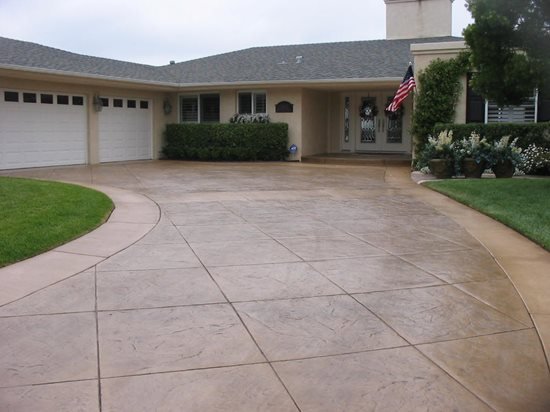The Environment-friendly Option: Concrete Sidewalks for Your Area
Concrete walkways are a common attribute in a lot of communities, yet their effect on the setting is usually overlooked. Nevertheless, picking concrete for your community walkways can make a significant difference in terms of sustainability and eco-friendliness. The benefits of going with concrete exceed simple visual appeals and performance. By considering the ecological advantages and lasting impacts on the area, the option of materials for pathways comes to be an important choice. Allow's explore why concrete sidewalks could be the eco-friendly choice your neighborhood requires.
Benefits of Concrete Sidewalks
When considering the setup of pathways in a neighborhood, the benefits of choosing concrete over other materials are numerous and considerable. Concrete walkways provide durability, standing up to heavy foot traffic, weather variations, and environmental components better than alternate products like asphalt or gravel. This durability translates to cost-effectiveness in the future, as concrete pathways require much less regular repair work and upkeep. Furthermore, concrete is a functional product that can be conveniently customized to match the aesthetic of any community through different surfaces, colors, and patterns.

Longevity and Durability
How can concrete walkways surpass various other products in regards to toughness and durability? Concrete pathways are renowned for their extraordinary sturdiness and longevity compared to different materials like asphalt or pavers. The intrinsic strength of concrete makes it extremely immune to cracking, changing, and general damage brought on by foot website traffic, climate fluctuations, and various other environmental elements. Unlike asphalt, which can soften in heats and fracture in freezing problems, concrete preserves its architectural stability, needing minimal maintenance in time.
Concrete sidewalks additionally have a longer life-span than pavers, which are susceptible to unequal settling, weed development in between joints, and specific paver activity. The strong, continual surface area of concrete minimizes stumbling hazards and guarantees a smooth walking course for pedestrians. Additionally, concrete's durability lowers the requirement for regular repair services or substitutes, making it a sustainable and cost-efficient option for neighborhood sidewalks. By purchasing concrete sidewalks, neighborhoods can appreciate a reliable and durable infrastructure that improves the overall visual allure and functionality of the area.
Reduced Maintenance Requirements
Concrete pathways attract attention for their minimal maintenance requirements due to their long lasting nature and durable efficiency. Unlike alternative products that may require frequent fixings or substitutes, concrete sidewalks use an economical remedy that requires little maintenance over time. One of the vital advantages of concrete pathways is their resistance to weathering and erosion. This browse around this site suggests they can hold up against rough climate problems, heavy foot traffic, and various other environmental aspects without wearing away promptly.
Routine upkeep for concrete pathways usually involves simple jobs such as routine cleaning to eliminate debris and periodic sealing to protect the surface area. In comparison to products like asphalt or pavers that may change, crack, or weaken more easily, concrete walkways preserve their architectural stability with minimal treatment. Additionally, any kind of repairs that might be needed are usually local and can be resolved swiftly, lowering both the time and cost associated with maintenance.

Ecological Benefits
With a focus on sustainability and eco-friendliness, concrete pathways supply notable environmental advantages that contribute to a greener community framework. In addition, concrete pathways have a high solar reflectance index, indicating they reflect a substantial quantity of sunlight instead of maintaining and taking in warm.
Additionally, concrete is a permeable product that allows water to infiltrate right into the ground, decreasing stormwater runoff and helping in groundwater recharge. This helps stop erosion, minimize flooding, and maintain the all-natural balance of water supply in the neighborhood. By selecting concrete walkways, neighborhoods can make a lasting selection that positively affects the environment and enhances the lifestyle for citizens.
Enhancing Area Sustainability
By prioritizing lasting infrastructure options, neighborhoods can cultivate a harmonious balance in between environmental awareness and area growth. Enhancing neighborhood sustainability entails a diverse technique that goes past simply the ecological advantages of concrete walkways. Applying environment-friendly spaces, advertising energy-efficient techniques, and fostering a sense of community interaction are crucial parts of developing a lasting area.
One way to improve area sustainability is via the assimilation of absorptive concrete walkways. These sidewalks permit rain to leak into the ground, decreasing stormwater runoff and minimizing the pressure on municipal drain systems. Legendary Concrete Brentwood. By incorporating permeable sidewalks, communities can improve water quality, decrease flooding threats, and improve total ecological durability
Moreover, promoting different transportation techniques such as walking and cycling can dramatically minimize carbon emissions and advertise a much healthier lifestyle amongst locals. Producing risk-free pedestrian paths, bike blog lanes, and designated greenways can motivate residents to depend much less on cars, even more contributing to the area's sustainability objectives.
Final Thought
To conclude, concrete pathways supply many advantages for neighborhoods, consisting of sturdiness, low maintenance demands, and environmental benefits. By picking concrete visit homepage walkways, areas can enhance their sustainability and contribute to a more green setting. It is clear that concrete pathways are the ideal selection for neighborhoods aiming to enhance their infrastructure in a environmentally friendly and resilient way.
When thinking about the installation of pathways in an area, the benefits of selecting concrete over other products are considerable and various. Additionally, concrete's longevity lowers the requirement for constant fixings or replacements, making it a economical and sustainable selection for neighborhood walkways (Concrete Companies Near Me).With an emphasis on sustainability and eco-friendliness, concrete sidewalks supply notable environmental advantages that add to a greener area infrastructure. Enhancing neighborhood sustainability includes a diverse approach that goes beyond just the ecological advantages of concrete pathways.In conclusion, concrete sidewalks use many benefits for areas, consisting of sturdiness, reduced upkeep requirements, and ecological advantages